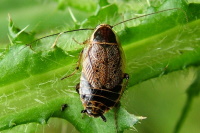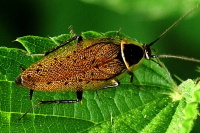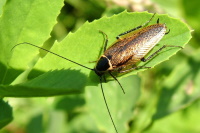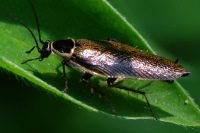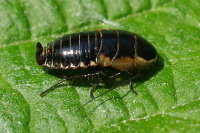Phylum Arthropoda (Arthropods) ➔ Subphylum Hexapoda (Hexapods) ➔ Class Insecta (Insects) ➔ Order Blattodea (Cockroaches, termites) ➔ Family Ectobiidae
Ectobius (Ectobius) sylvestris (Poda, 1761)
Waldschabe Forest Cockroach
Synonyms and other combinations:
Blatta sylvestris Poda, 1761 |
Further vernacular names:
Lesser CockroachClassification:
Ectobius sylvestris belongs to the subfamily Ectobiinae.Distribution:
Palearctic (except North Africa, Canary Islands, Iberian Peninsula, Great Britain).Habitat:
Light forests and forest edges, up to subalpine and alpine altitudes.Habitus:
The Forest Cockroach has a dark brown to black colored pronotum with bright, transparent edges. The brownish tegmina (forewings) show some small dark spots in the middle of the wing. Only the males with fully developed forewings covering the whole abdomen are able to fly. The forewings of the flightless females cover the abdomen about up to half. Body length data vary between 7 - 11 mm and 9 - 14 mm.Biology:
The Forest Cockroach Ectobius sylvestris can be found from May to September, often on bushes and in the herbaceous layer at forest trails. The species is predominantly diurnal. Their representatives feed on rotting plant parts.After mating, the females lay their eggs bundled in an ootheca on sites suitable for the development of the nymphs (e.g. in the foliage layer on the ground). The nymphs of the genus Ectobius go through 5 to 6 stages to the imago. Ectobius sylvestris is likely to have a two-year development cycle. Hibernation takes place at sheltered sites in the soil layer.
The native Forest Cockroach Ectobius sylvestris does not belong to the synanthropic species known as storage pests and potential disease carriers.
References, further reading, links:
- Beccaloni G.W. (2016). CockroachSF: Cockroach Species File (version 5.0/5.0, Dec 2015). In: Species 2000 & ITIS Catalogue of Life, 2016 Annual Checklist (Roskov Y., Abucay L., Orrell T., Nicolson D., Flann C., Bailly N., Kirk P., Bourgoin T., DeWalt R.E., Decock W., De Wever A., eds). Digital resource at www.catalogueoflife.org/annual-checklist/2016. Species 2000: Naturalis, Leiden, the Netherlands. ISSN 2405-884X.
